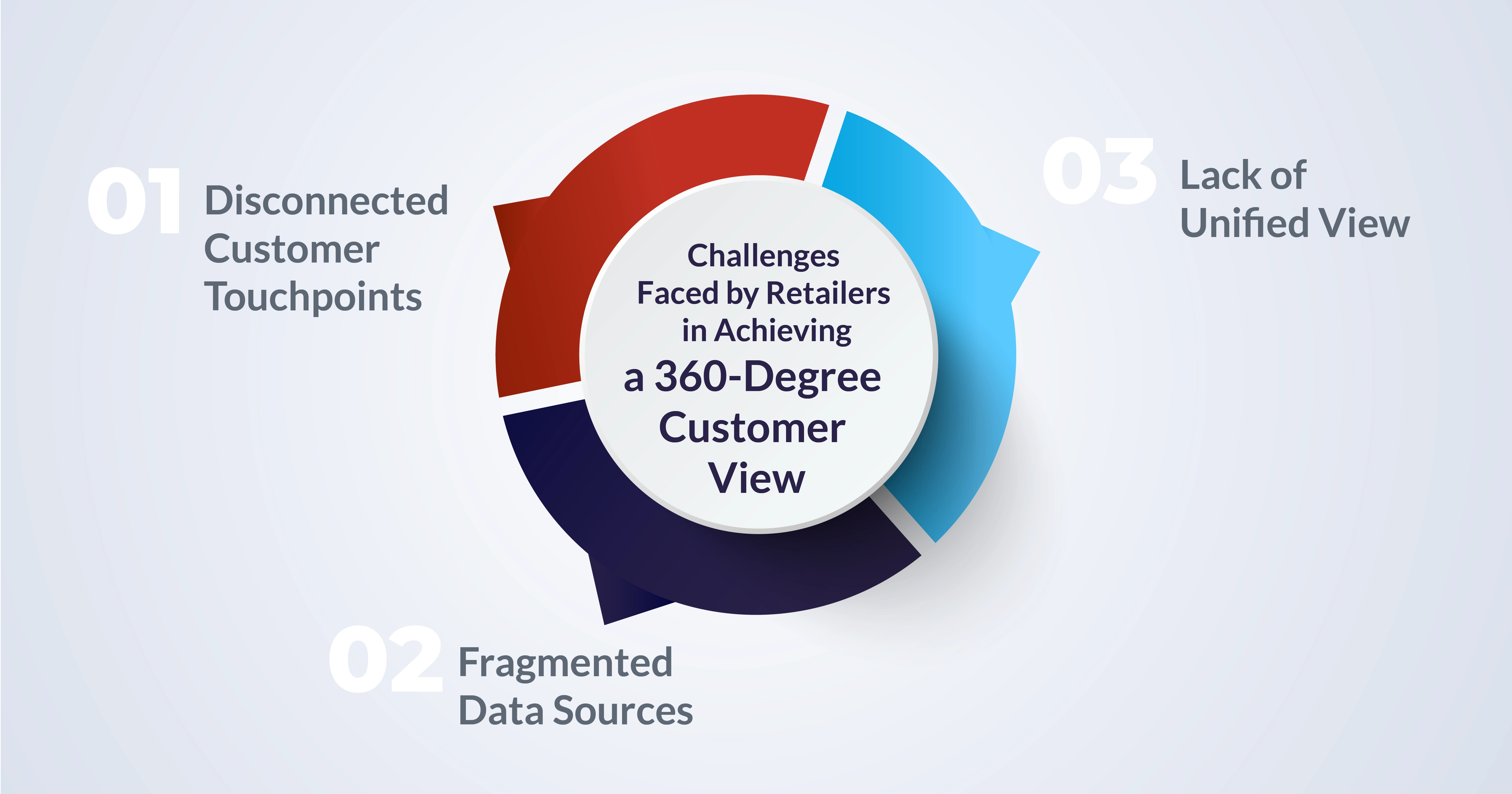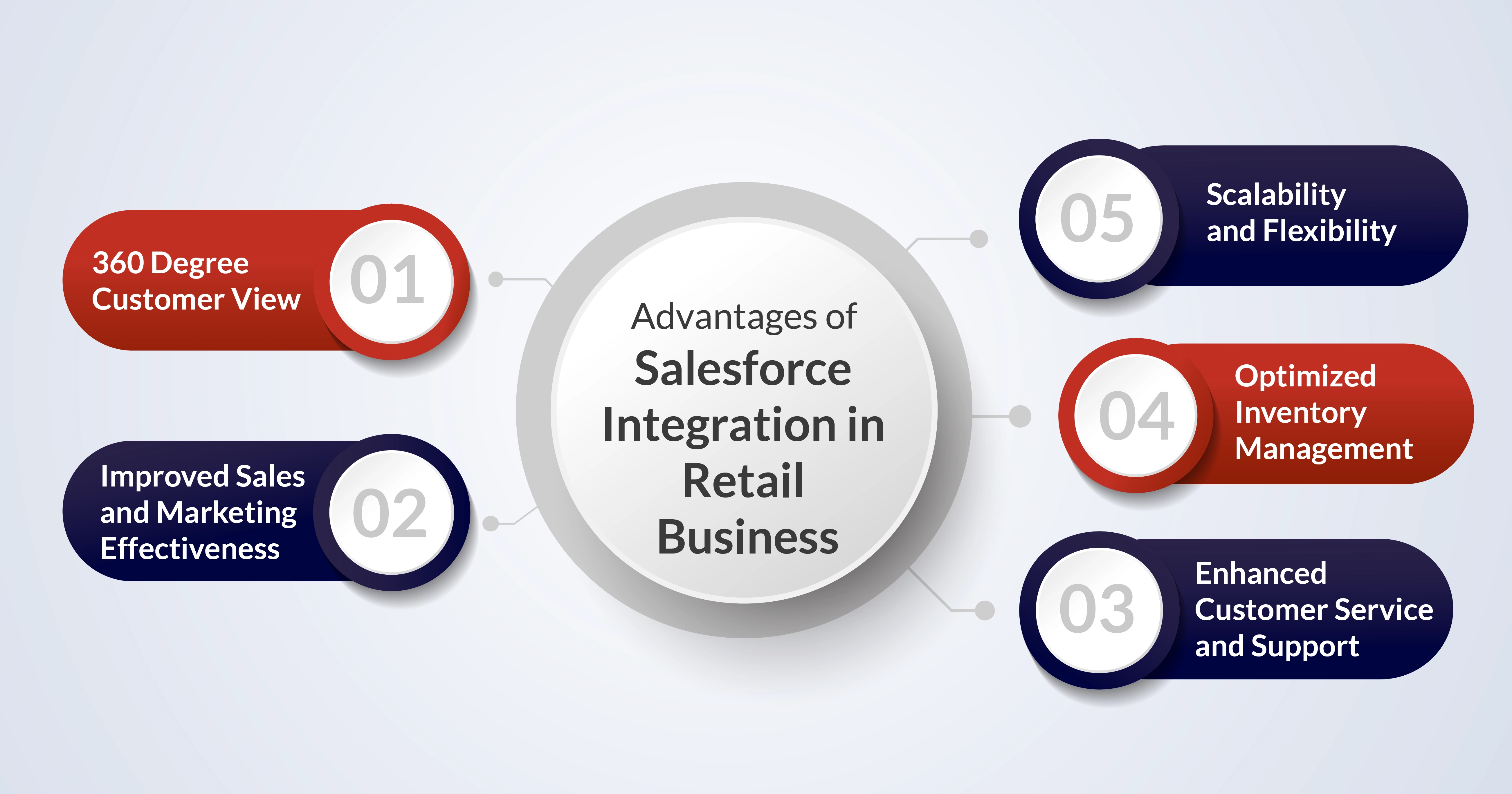Quick Links
- Definition of 360-Degree Customer Insight
- Importance of Optimizing Salesforce Integration in Retail
- Understanding the Challenges
- Benefits of Salesforce Integration in Retail
- Strategies for Optimizing Integration
- Overcoming Data Silos
- Achieving a Unified Customer View
- The Future of Retail with 360-Degree Customer Insight - Emerging Technologies and Opportunities
- How can Bolt Today Help?
360-Degree Customer Insight: Optimizing Salesforce Integration to Overcome Challenges Across Retail Channels

Nothing is more important than having a complete understanding of how your customer buys from you. Without it, your marketing strategies will fall flat in today's personalized shopping landscape. It's time to level up your game with a dive into the world of 360-degree customer insight through Salesforce Integration.
Imagine having the power to anticipate every twist and turn in your customers' journey. From their first click to their final purchase, tap into the secrets to truly understand your customers on a whole new level. Get ready to transform your approach to retail and discover the keys to success in the age of personalized shopping experiences.
At its core, 360-degree customer insight refers to the comprehensive understanding of customers gained by aggregating data from all available sources, both online and offline, to create a unified view. It encompasses not only demographic information and purchase history but also behavioral data, preferences, feedback, and interactions across various channels such as websites, mobile apps, social media, and in-store visits.
By compiling this wealth of information into a single, cohesive profile, businesses can gain deep insights into their customers' preferences, needs, and habits.
Importance of Optimizing Salesforce Integration in Retail
In the current era of digital transformation, where consumers demand personalized experiences and seamless interactions across channels, optimizing Salesforce integration has become increasingly critical for retailers. Salesforce offers a powerful suite of tools and capabilities designed to streamline customer data management and enhance engagement. By integrating Salesforce with various retail systems such as point-of-sale (POS), e-commerce platforms, marketing automation tools, and customer service applications, retailers can achieve several key benefits:
360-Degree Customer View
By synchronizing data from disparate sources into Salesforce, retailers can create a 360-degree view of each customer, consolidating information such as purchase history, preferences, interactions, and feedback into a single, comprehensive profile. This allows businesses to gain a deeper understanding of their customers' behavior and preferences, enabling more targeted marketing campaigns, personalized recommendations, and tailored experiences.
Seamless Cross-Channel Communication
With Salesforce integration, retailers can ensure seamless communication and consistency across all customer touchpoints, whether online, offline, or through mobile devices. This enables customers to transition effortlessly between channels, such as browsing products online and completing their purchase in-store, with their information and preferences seamlessly synced in real-time.
Improved Customer Engagement
By leveraging the rich insights provided by Salesforce integration, retailers can deliver more relevant and timely communications to their customers, leading to higher levels of engagement and satisfaction. Whether through personalized email campaigns, targeted promotions, or proactive customer service, businesses can anticipate and fulfill their customer's needs more effectively, fostering stronger relationships and driving repeat business.
Understanding the Challenges

In the pursuit of achieving a comprehensive understanding of customers through 360-degree insight, retailers often encounter plenty of challenges. These hurdles not only impede the process of gathering and analyzing data but also hinder the ability to create a unified view of the customer. Let's delve into three primary challenges faced by retailers in this regard:
1. Disconnected Customer Touchpoints
Another significant challenge in achieving 360-degree customer insight is the presence of disconnected customer touchpoints. In today's omnichannel retail environment, customers expect a seamless experience across all channels, whether they are shopping online, in-store, or via mobile devices. However, many retailers struggle to integrate these various touchpoints into a cohesive customer journey.
For instance, a customer may start their shopping journey by browsing products on a retailer's website, add items to their cart, and then abandon the purchase. Later, they may receive a promotional email from the retailer, prompting them to revisit the website and complete their purchase. Without proper integration between the website, email marketing platform, and other systems, retailers may fail to recognize the customer's previous interactions and provide a personalized experience, leading to frustration and disengagement.
2. Fragmented Data Sources
One of the most significant obstacles to achieving 360-degree customer insight is the presence of fragmented data sources. In many retail organizations, data is dispersed across various systems and platforms, including POS systems, e-commerce platforms, customer relationship management (CRM) software, social media channels, and more. Each of these sources collects valuable information about customer interactions, transactions, preferences, and behaviors. However, without integration, this data remains siloed and disjointed, making it challenging to gain a holistic understanding of the customer journey.
For example, a customer may interact with a retailer through multiple touchpoints, such as browsing products on the website, engaging with the brand on social media, and making a purchase in-store. Without a unified approach to data collection and aggregation, these interactions may be recorded separately in different systems, preventing retailers from connecting the dots and gaining insights into the customer's entire journey. Encore executive cost and delivery
3. Lack of Unified View
Perhaps the most significant challenge of all is the lack of a unified view of the customer. Even if retailers can overcome the hurdles of fragmented data sources and disconnected touchpoints, they often struggle to consolidate this information into a single, cohesive view of each customer. Without a unified view, retailers are unable to gain a comprehensive understanding of customer preferences, behaviors, and needs, making it difficult to deliver personalized experiences and targeted marketing campaigns.
For example, a retailer may have customer data scattered across multiple systems, with each system providing only a partial view of the customer. Without a centralized repository for storing and analyzing this data, retailers may miss out on valuable insights, incur excessive costs in delivery and reduce customer engagement effectively.
Benefits of Salesforce Integration in Retail

1. 360 Degree Customer View
By integrating Salesforce with various retail systems, such as point-of-sale (POS), e-commerce platforms, and customer service applications, retailers can create a unified view of each customer. This consolidated data enables businesses to gain insights into customer preferences, behaviors, and purchase history, empowering them to deliver personalized experiences and targeted marketing campaigns. This would have a dramatic positive impact on your customer’s engagement with the brand.
2. Improved Sales and Marketing Effectiveness
With Salesforce integration, retailers can leverage powerful tools such as Sales Cloud and Marketing Cloud to streamline sales and marketing processes. Sales teams can track leads, manage opportunities, and forecast revenue more effectively, while marketing teams can create and execute targeted campaigns based on real-time customer data.
3. Enhanced Customer Service and Support
Salesforce's Service Cloud enables retailers to deliver exceptional customer service and support across all channels, including phone, email, chat, and social media. By centralizing customer inquiries, cases, and interactions, retailers can provide timely and personalized assistance, leading to higher levels of satisfaction and loyalty.
4. Optimized Inventory Management
By integrating Salesforce with inventory management systems, retailers can gain visibility into stock levels, product availability, and order fulfillment processes. This real-time visibility allows businesses to optimize inventory levels, reduce stockouts, and improve order accuracy, ultimately enhancing the customer shopping experience.
5. Scalability and Flexibility
Salesforce's cloud-based architecture offers unparalleled scalability and flexibility, allowing retailers to adapt and grow with changing business needs. Whether expanding into new markets, launching new products, or integrating with third-party applications, Salesforce provides a solid foundation for future growth and innovation.
Strategies for Optimizing Integration
In the pursuit of achieving seamless integration between Salesforce and other retail systems, several key strategies can significantly enhance the effectiveness and efficiency of the integration process. Let's explore three fundamental strategies for optimizing integration:
Data Standardization and Cleansing
A crucial aspect of integration optimization is ensuring that data from various sources adhere to consistent standards and formats. This involves standardizing data fields, formats, and naming conventions across different systems to facilitate smooth data exchange and accurate analysis within Salesforce. Additionally, data cleansing processes such as deduplication, normalization, and validation are essential for maintaining data integrity and reliability. By standardizing and cleansing data before integration, retailers can minimize errors, improve data quality, and ensure that accurate insights drive informed decision-making within Salesforce.
Seamless Cross-Channel Communication
Another critical strategy for optimizing integration is enabling seamless communication and data exchange across different channels and touchpoints. In today's omnichannel retail environment, customers expect a consistent and personalized experience regardless of the channel they engage with. Integrating Salesforce with various retail systems, including e-commerce platforms, POS systems, mobile apps, and social media channels, enables retailers to capture customer interactions and preferences across multiple touchpoints in real-time.
This comprehensive view of the customer journey empowers retailers to deliver personalized experiences, targeted promotions, and timely responses to customer inquiries, thereby enhancing customer satisfaction and loyalty.
Real-Time Data Syncing
Real-time data syncing is essential for ensuring that information is up-to-date and accurate across all integrated systems. By synchronizing data in real-time between Salesforce and other retail systems, retailers can access the latest customer information, transactional data, inventory levels, and order statuses without delays or discrepancies.
Real-time data syncing enables retailers to respond promptly to customer inquiries, update inventory levels, and track sales performance in real-time, thereby improving operational efficiency and agility. Additionally, real-time data syncing allows retailers to identify and capitalize on emerging trends, customer preferences, and market opportunities, enabling them to stay ahead of the competition and drive business growth.
Overcoming Data Silos
Data silos, whether internal or external, pose significant challenges to achieving seamless integration and a unified view of customer data within Salesforce. Let's explore strategies for overcoming these silos:
Breaking Down Internal Silos
Internal data silos occur when different departments or teams within an organization operate in isolation, each managing its own set of data without sharing information with others. This fragmentation hinders collaboration, decision-making, and the ability to provide a cohesive customer experience. To break down internal silos, organizations must foster a culture of data sharing and collaboration across departments. This involves:
- Establishing clear communication channels and protocols for sharing data and insights.
- Implementing cross-functional teams and projects that require collaboration between departments.
- Encouraging transparency and accountability in data management practices.
- Investing in training and education to promote data literacy and understanding across the organization.
By breaking down internal silos and promoting cross-departmental collaboration, organizations can unlock the full potential of their data and ensure that Salesforce integration efforts are aligned with broader business objectives.
Integrating External Systems
External data silos arise when organizations rely on disparate systems and platforms that are not integrated with Salesforce, leading to fragmented data and inefficiencies in data management. To integrate external systems with Salesforce, organizations can take several steps:
- Identify key external systems and data sources that are critical to the customer journey, such as e-commerce platforms, marketing automation tools, and third-party databases.
- Evaluate integration options and technologies that enable seamless data exchange and synchronization between Salesforce and external systems. This may involve leveraging pre-built connectors, APIs, or middleware solutions.
- Develop a comprehensive integration strategy that defines data mapping, synchronization schedules, error handling procedures, and security protocols.
- Implement and test the integration solution to ensure data accuracy, reliability, and consistency across all integrated systems.
By integrating external systems with Salesforce, organizations can eliminate data silos, streamline data flows, and create a unified view of customer data that enables more informed decision-making and personalized customer experiences.
Achieving a Unified Customer View
In the quest for a comprehensive understanding of customers, achieving a unified view is paramount. A unified view consolidates data from various touchpoints and interactions into a single, cohesive profile, providing organizations with invaluable insights into customer behavior, preferences, and needs. Two key strategies for achieving a unified customer view are developing a single customer profile and comprehensive customer journey mapping:
Single Customer Profile
At the heart of a unified customer view lies the concept of a single customer profile—a centralized repository that houses all relevant information about an individual customer. This profile aggregates data from multiple sources, including CRM systems, e-commerce platforms, customer service interactions, marketing campaigns, and more. By consolidating data into a single customer profile, organizations can gain a holistic understanding of each customer's interactions, preferences, purchase history, and engagement across various channels. Developing a single customer profile involves:
Data Integration:
Integrating data from disparate sources into a central CRM system, such as Salesforce, ensures that all customer interactions are captured and stored in a unified format.Data Enrichment:
Enriching customer profiles with additional data points, such as demographic information, psychographic data, and behavioral insights, enhances the depth and richness of customer understanding.Identity Resolution:
Resolving identity across multiple channels and touchpoints ensures that all interactions associated with a particular customer are accurately attributed to their profile, avoiding duplication and inconsistencies.Real-Time Updates:
Maintaining real-time updates to customer profiles ensures that organizations have access to the most current and relevant information, enabling timely and personalized interactions.
By leveraging a single customer profile, organizations can personalize marketing efforts, tailor product recommendations, and deliver exceptional customer experiences that drive loyalty and satisfaction.
Comprehensive Customer Journey Mapping
In addition to a single customer profile, comprehensive customer journey mapping is essential for achieving a 360-degree view of the customer. Customer journey mapping involves visualizing and understanding the various touchpoints and interactions that a customer experiences throughout their relationship with a brand—from initial awareness to post-purchase support. Key components of comprehensive customer journey mapping include:
Identifying Touchpoints:
Mapping out all the touchpoints and channels through which customers interact with the brand, including online and offline channels such as websites, social media, email, mobile apps, and in-store experiences.Understanding Customer Behavior:
Analyzing customer behavior at each touchpoint to identify patterns, preferences, and pain points. This includes tracking interactions, engagement metrics, and sentiment analysis to gain insights into customer sentiment and satisfaction.Mapping Customer Goals:
Understanding the goals, motivations, and needs driving customer interactions at each stage of the journey. This enables organizations to align their marketing messages, product offerings, and service experiences with customer expectations.Optimizing the Journey:
Continuously monitoring and optimizing the customer journey based on data-driven insights and feedback. This involves identifying areas of friction or opportunity and implementing strategies to enhance the overall customer experience.
By comprehensively mapping the customer journey, organizations can identify opportunities for improvement, optimize touchpoints, and deliver a seamless and cohesive experience that delights customers at every stage of their interaction with the brand.
Dive into the world of
360-Degree Customer Insight
By integrating Salesforce today!
Contact Us
The Future of Retail with 360-Degree Customer Insight - Emerging Technologies and Opportunities
The future of retail customer experience is also being shaped by a wave of emerging technologies and opportunities that hold the potential to revolutionize the way retailers engage with customers and drive business growth. Here are some key technologies and opportunities to watch:
Artificial Intelligence (AI) and Machine Learning:
AI and machine learning are poised to transform retail by enabling retailers to analyze vast amounts of data, predict customer behavior, and deliver personalized experiences in real-time. AI-powered chatbots and virtual assistants can provide personalized assistance to customers, while AI-driven analytics can uncover valuable insights into customer preferences and trends.Augmented Reality (AR) and Virtual Reality (VR):
AR and VR technologies are opening up new possibilities for immersive shopping experiences, allowing customers to visualize products in their own environment before making a purchase. From virtual try-on experiences in fashion retail to interactive product demos in home furnishings, AR and VR are enhancing engagement and driving conversion rates.Internet of Things (IoT) and Connected Devices:
The proliferation of IoT devices and connected technologies is enabling retailers to gather real-time data from physical environments, such as stores and warehouses, to optimize operations and enhance the customer experience. IoT-enabled smart shelves, beacons, and RFID tags can provide retailers with insights into customer behavior, inventory levels, and store traffic, enabling them to make data-driven decisions and deliver personalized experiences.
How can Bolt Today Help?
As a leading Salesforce consulting services provider, Bolt Today specializes in optimizing Salesforce integration for businesses. Here's how Bolt Today's expertise can benefit you:
Custom Solutions:
Tailored integrations ensure smooth connectivityData Quality:
Ensuring accuracy and consistency across systems.Real-time Syncing:
Keeping information current across all channels.Scalability:
Solutions adapt to changing business needs.Ongoing Support:
Continuous maintenance for seamless operations.
Teaming up with Bolt Today gives businesses the tools they need to make the most of Salesforce integration. This partnership means better access to data and smoother operations that can lead to success in the long run. With Bolt Today's expertise, you can improve how you see and use your data, making processes easier and more efficient. This kind of support can pave the way for growth and lasting achievements.